New York City officials are set to propose indoor air quality regulations, legislation that has been in the works for nearly a year but found new urgency after heavy smoke from Canadian wildfires shrouded the skies along the East Coast.
If adopted, two bills lawmakers are bringing forward Thursday would require the city to create standards to measure, monitor, report and enforce air quality inside schools and municipal buildings. Officials would have 18 months to craft such standards, which would be more detailed than current city building and health codes, proponents say.
Two other bills would create five-year pilot programs to analyze air quality in residential and commercial buildings, and the bills would go into effect four months after passage. While the proposed pilot programs would be voluntary for many residential and commercial buildings, buildings whose owners or developers receive city financial assistance after the legislation is in effect would be required to participate.
If the pilot programs go into effect, officials would later make recommendations for a permanent regulatory framework for residential and commercial buildings.
City Council member Keith Powers and Manhattan Borough President Mark Levine, both Democrats, led the drafting of the legislation. They said local leaders have been working on the language for nearly a year.
Their efforts were largely prompted by the pandemic, when improving indoor air quality became of particular importance in battling the spread of Covid-19. The proposals were altered to encompass climate change after the Canadian wildfire smoke, which added more recent urgency to the conversation.
“The way it impacted New York was a reminder that air quality is a health issue,” Levine said of the smoke.
The proposals follow updated guidance on ventilation in buildings from the Centers for Disease Control and Prevention, which in May recommended that the air in a space be changed five times per hour “to help reduce the number of germs in the air.”
Powers said the legislation lays out the framework under which rules and regulations will be created to gather information about indoor air quality and make it public. He and Levine hope the standards might be a model for other cities.
“There’s a lot of power in information for consumers and New Yorkers to have to make decisions about their behavior and their health,” Powers said.
The pair didn’t yet have an estimate on how much the to-be-decided indoor air standards might ultimately cost, but said they expected the costs to be outweighed by the public health benefits.
Improving indoor air quality was of particular concern in schools during the pandemic, but a federal survey of K-12 public school districts published in April showed that many public school districts “have not taken steps to improve school building ventilation.”
Of the more than 8,400 school districts that participated in the survey, just under 34% said that a replacement or upgrade of HVAC systems had been completed or was in progress. Meanwhile, 28% said they installed or used HEPA filtration systems in classrooms or student dining areas, or were in the process of doing so.













